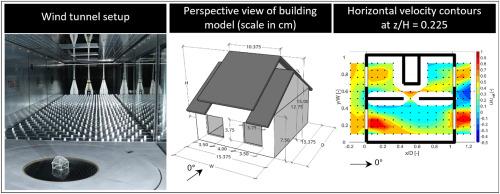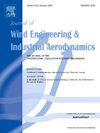风洞测量现实建筑几何形状中的交叉通风流:建筑隔墙和风向的影响
IF 4.2
2区 工程技术
Q1 ENGINEERING, CIVIL
Journal of Wind Engineering and Industrial Aerodynamics
Pub Date : 2024-10-04
DOI:10.1016/j.jweia.2024.105907
引用次数: 0
摘要
风洞测量被广泛用于验证自然通风气流的计算流体力学模拟。然而,此类测量大多采用简单的通用单区建筑,而缺乏对包含流动关键几何特征(如内部分区)的现实建筑的研究。为了评估内部隔板在不同入射流角(α = 0° 和 α = 30°)下的影响,我们在风洞中测量了交叉通风的现实住宅楼(有内部隔板和无内部隔板)内部和周围的速度。测量采用激光多普勒风速仪,几何比例为 1:40。结果表明,内部隔墙对室内气流分布和由此产生的通风流量有很大影响。例如,当 α = 0° 时,在隔断建筑一侧观察到速度增加的区域(从室外参考速度 Uref 的 ∼ 0 m/s 到 ∼ 80%),但也观察到速度降低的区域(从 Uref 的 ∼ 50% 到 ∼ 0 m/s)。通过隔断侧窗户的通风流量分别下降了 23% 和 32%。对于分隔建筑,从 α = 0° 到 α = 30° 的变化导致速度从 0 m/s 上升到 Uref 的 60%。本文章由计算机程序翻译,如有差异,请以英文原文为准。

Wind tunnel measurements of cross-ventilation flow in a realistic building geometry: Influence of building partitions and wind direction
Wind tunnel measurements have widely been used for validation of computational fluid dynamics simulations of natural ventilation airflows. However, the majority of such measurements employed simple generic single-zone buildings, while there is a lack of studies on realistic buildings including flow-critical geometrical features (e.g. internal partitions). To assess the effect of internal partitions at different incident flow angles (α = 0° and α = 30°), wind tunnel measurements of velocities in and around a cross-ventilated realistic residential building (with and without internal partition) were performed. Measurements were conducted at a geometric scale 1:40, using laser Doppler anemometry. Results indicate a large impact of the internal partition on indoor airflow distribution and resulting ventilation flow rates. For instance, for α = 0°, on the partitioned building side, regions of velocity increase (from ∼0 m/s to ∼80% of the outdoor reference velocity, Uref), but also regions of velocity decrease (from ∼50% of Uref to ∼0 m/s) were observed. The ventilation flow rate through the windows at the partitioned side decreased by 23% and 32%, respectively. For the partitioned building, a change from α = 0° to α = 30° resulted in regions of velocity increase from 0 m/s to ∼60% of Uref.
求助全文
通过发布文献求助,成功后即可免费获取论文全文。
去求助
来源期刊
CiteScore
8.90
自引率
22.90%
发文量
306
审稿时长
4.4 months
期刊介绍:
The objective of the journal is to provide a means for the publication and interchange of information, on an international basis, on all those aspects of wind engineering that are included in the activities of the International Association for Wind Engineering http://www.iawe.org/. These are: social and economic impact of wind effects; wind characteristics and structure, local wind environments, wind loads and structural response, diffusion, pollutant dispersion and matter transport, wind effects on building heat loss and ventilation, wind effects on transport systems, aerodynamic aspects of wind energy generation, and codification of wind effects.
Papers on these subjects describing full-scale measurements, wind-tunnel simulation studies, computational or theoretical methods are published, as well as papers dealing with the development of techniques and apparatus for wind engineering experiments.

 求助内容:
求助内容: 应助结果提醒方式:
应助结果提醒方式:


